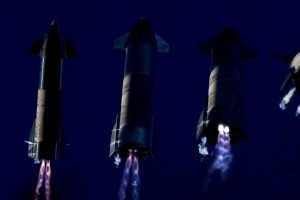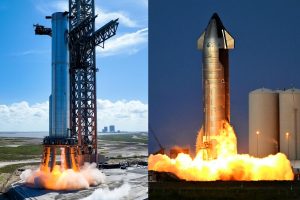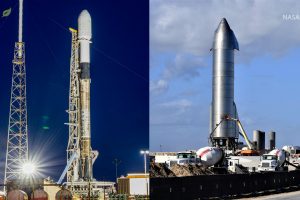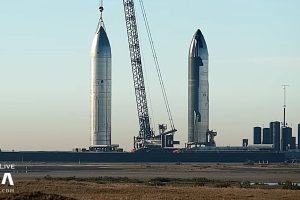SpaceX appears to have successfully fired up a Starship and Super Heavy booster hours apart, testing a total of three new Raptor 2 engines on the two rockets.
SpaceX says it completed a two-engine static fire with Starship 24 less than three hours after the company successfully ignited a Raptor 2 engine installed on a rocket prototype for the first time. That earlier test, performed by Super Heavy Booster 7, was also the first time SpaceX used its new Starbase orbital launch site to support a static fire test and the second-ever static fire of a Starship booster prototype. Had the company called it quits after Booster 7 survived its first intentional trial by fire, it would have still been an exceptionally successful day.
But SpaceX wasn’t done.
Instead, after Booster 7’s seemingly flawless single-Raptor static fire at 5:25 pm CDT, SpaceX loaded Starship 24 with a small amount of liquid oxygen and methane propellant and ignited two of the ship’s six engines around 8:18 pm. It was not initially clear how many engines were involved but a tweet from SpaceX later confirmed it was two. More likely than not, one of those engines was a sea level-optimized Raptor with a smaller bell nozzle and the other was a vacuum-optimized Raptor with a much larger nozzle.
Almost ten months ago, Starship 20 – SpaceX’s first potentially orbital-class Starship prototype – began static fire testing in a somewhat similar way. Its first day of static fires began with a single Raptor Vacuum engine and ended with a simultaneous RVac and sea-level Raptor test in October 2021. In some ways, SpaceX has been a bit less cautious with Starship 24, which is the second potentially orbital-class prototype to begin proof testing. Ship 24 already has all six Raptors installed, whereas Ship 20 only had four of six engines installed during its first static fire tests. SpaceX also took about three weeks to progress from Ship 20’s first static fire test to its first static fire of all six engines, whereas it appears that Ship 24 could potentially attempt its first six-engine test just a few days to a week later.
On the other hand, Ship 24’s path to its first static fire was substantially longer than Ship 20’s. Ship 20 completed its first static fire test(s) just 25 days after its first proof test, referring to the process of verifying that the prototype was in good working order before moving on to riskier testing with flammable propellant and intentional ignitions. Ship 20 also completed its first six-engine static fire 46 days after testing began. Ship 24, meanwhile, took 75 days to go from its first proof test to its first static fire – almost three times slower than Ship 20, a prototype that was essentially the first of its kind.
It’s possible that Ship 24’s upgraded Raptor 2 engines are partially or fully to blame. Instead of jumping straight into ‘hot’ Raptor testing like Ship 20, which began that particular campaign with a partial-ignition preburner test, SpaceX put Ship 24 through seven ‘spin-prime’ tests before its first static fire. For Raptor, spin-primes test the ignition step before preburner ignition, which is itself a step before main combustion chamber ignition (where the engine starts to produce meaningful thrust). Raptor startup procedures likely initially involve flowing high-pressure gaseous helium, nitrogen, or propellant (oxygen/methane) through the engine to spin up its turbopumps, ‘priming’ them for preburner and main combustion chamber ignition.
In a recent interview with Tim Dodd (“The Everyday Astronaut”), CEO Elon Musk revealed that SpaceX was able to “remove torch igniters” from Raptor 2’s main combustion chamber (MCC). It’s unclear if that means that Raptor 2 now has zero MCC igniters, but a major change in the overall ignition process could explain why the start of Ship 24 and Booster 7 engine testing was so sluggish. So could the unintended explosion Booster 7 caused when SpaceX attempted to spin-prime all 33 of its Raptor 2 engines at once.
Regardless, SpaceX has finally crossed that particular Rubicon and, with any luck, Raptor 2 testing will begin to speed up on both Starship 24 and Super Heavy Booster 7. SpaceX has test windows scheduled on August 11th, 15th, and 16th. A warning distributed to Boca Chica, Texas residents on August 10th confirmed that the company intends to perform at least one more static fire test on the 11th.





